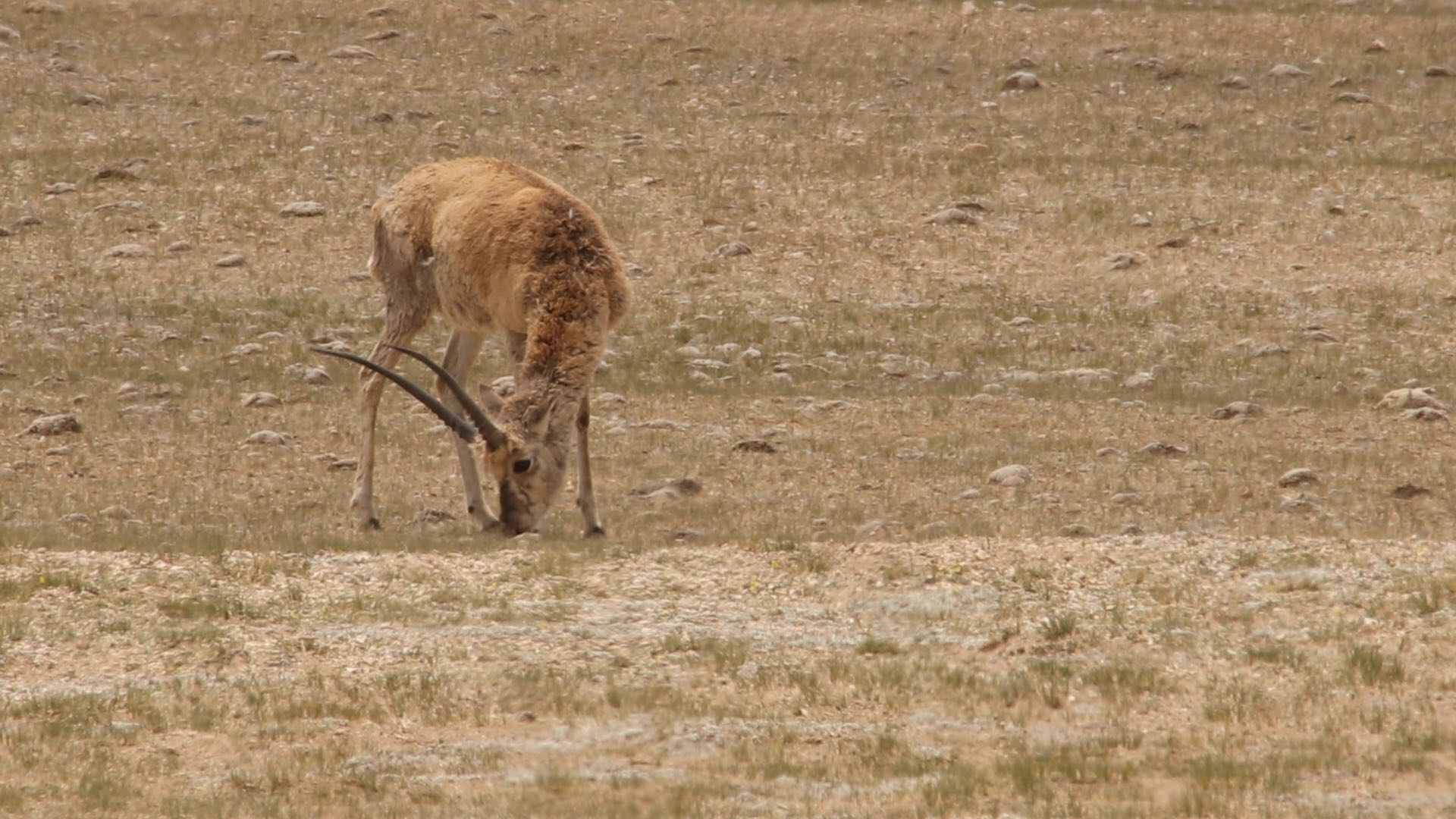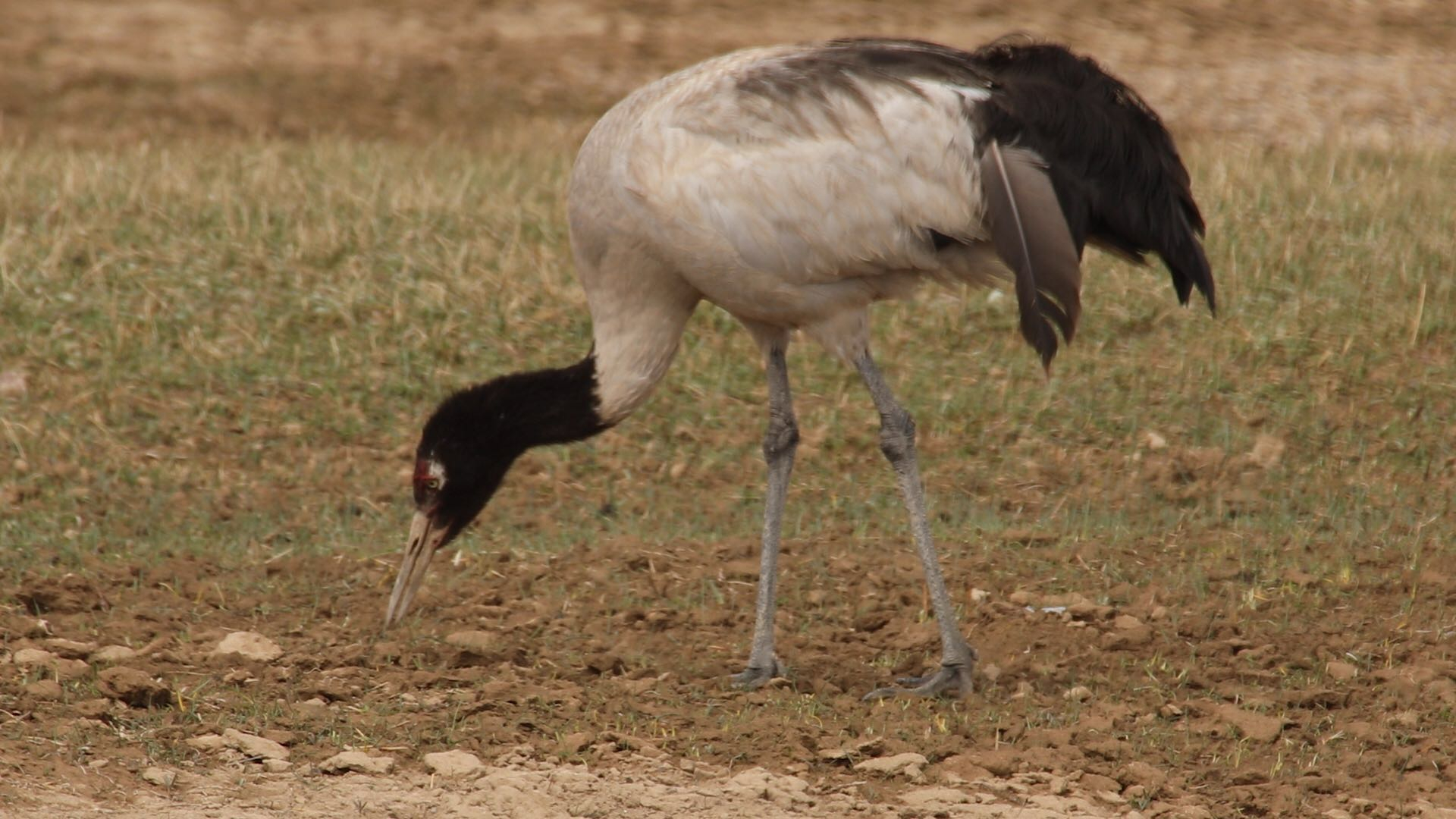
When herder Zheba was 40 years old, there were only 1,000 to 2,000 Tibetan antelope at Selincuo National Nature Reserve in China's Tibet Autonomous Region. That's when he decided to work part-time as a wildlife ranger. This year, Zheba celebrated his 50th birthday and is raising his fifth child, while the numbers of his protégés, the antelope, have more than tripled.
"I'm delighted that the Tibetan antelope receives first-class national protection and the awareness it deserves," he said.

Zheba, 50, a wildlife ranger at Selincuo National Nature Reserve, Xianza County, Nagqu Prefecture of China's Tibet Autonomous Region. /Photo: Zhou Jinxi, CGTN
Fragile environment
For China, the slow but sure comeback of Tibet's flagship animals, the black-necked crane, and Tibetan antelope, is a success story.
It's a success made possible by local wildlife rangers like Zheba, who volunteer for as much as 600 yuan (about 86 U.S. dollars) per month for daily patrols on their motorcycles, during Winter at 20 degrees Celsius below zero, through the sheer endless alpine tundra and wetlands, where the animals graze, feed, nest and breed.
The Qinghai-Tibet Plateau on the southwestern tip of China is the world's highest plateau, with an average altitude of 4,000 meters, while Selin Lake in the northern Nagqu Prefecture of the Tibet Autonomous Region is located over 4,500 meters above sea level. Due to glacier melting, the saltwater lake has been growing to become Tibet's largest lake.
The mountainous wetland geography and alpine climate surrounding the lake are home to vast biodiversity, fascinating creatures nowhere else to be found, such as the black-necked crane and the Tibetan antelope, but also snow leopards, wild donkeys, the Pallas's cat, and the Tibetan-aged sheep. However, the ecosystem surrounding the lake is rare and fragile. The population of those species declined rapidly due to hunting and other human interference that surged with the modernization of Tibet in the past almost 70 years.

The Tibetan antelope is under first-class national protection in China and its numbers are increasing. /Photo: Andrew Smith, CGTN
Threatened by modernization
The Tibetan antelope, on the one hand, declined in population due to its fine wool, sought after by the fashion industry. Also, as the wild animals had to compete with domestic livestock, their habitat was increasingly fragmented, the Wildlife Conservation Society explains, adding that their population has decreased from formerly one million in total (estimated) to 70,000 animals in the 1980s.
The black-necked crane, on the other hand, a first-class protected species in China, feeds on farmer's grain stubble in Winter. With changing agricultural practices, the bird is no longer able to depend on those farming communities for its survival in Winter, WWF says on its website, adding that its summer habitat, high-altitude wetlands, where it feeds on small insects, worms and plant roots, are also decreasing due to reasons pertaining to drainage, pollution, river dams and climate change.
Black-necked cranes avoid areas where trees and shrubs provide convenient hiding places for approaching predators – while local governments have been implementing tree-planting programs along river beds to fight desertification and prepare the land for eventually planting crops.
Also, with the increase of livestock, herding dogs pose a substantial risk, as they have been seen to eat the bird's precious eggs or baby cranes, of whom a nesting pair produces a maximum of two each year. As a result, the bird's numbers dwindled to an estimated 5,000 to 6,000 in 2006, according to WWF.

The black-necked crane is under first-class protection in China, while his habitat is still threatened. /Photo: Andrew Smith, CGTN
No cars, more diversity
Taqi, the supervisor of all wildlife rangers in Silincuo Nature Reserve, was responsible for building fences so the local herders would not cross the wildlife's foraging, breeding and nesting bases.
"We have an alarm system among the local population," he explained, "when people see someone crossing the fence, they will call us, if they got network signal."
On the nearby Cuo' e Lake, the diversity of birds spending the summer months on a small island has increased during the past ten years Taqi spent as a wildlife ranger's supervisor, he said.
There were only bar-headed gooses, when he just started, and a few brown-headed gulls. By providing those birds a safe habitat, more and more types of birds came to the reserve, up to 80 different kinds at a time.
"We keep the humans out," Taqi said. "In some areas, they can walk or ride a motorcycle to pass through. But cars or trucks are strictly prohibited."

Taqi, 30, oversees a group of wildlife rangers at Selincuo National Nature Reserve, Xianza County, Nagqu Prefecture of China's Tibet Autonomous Region. /Photo: Zhou Jinxi, CGTN
To protect the black-necked crane and Tibetan antelope, China established a reserve of over 400,000 square kilometers in 1993 around Selin Lake, where both species have an essential nesting or breeding site. In 2003, an area of 1,8940 square kilometers was upgraded to the Selincuo National Nature Reserve to further protect the endangered species. Works are underway to expand the nature reserve to establish the World's Third Pole National Park on the Qinghai-Tibet Plateau, China Daily reported in 2017.
Today, the IUCN Red list classifies the crane as "vulnerable" species, estimating the numbers of mature individuals from 6,600 to 6,800 with a tendency to decrease worldwide, while the Tibetan antelope is listed as "near threatened," with numbers estimated to fluctuate between 100,000 and 150,000 globally and increasing.
(Zhou Jinxi also contributed to this story.)
(Cover: A pair of black-necked crane flies over a wetland in Selincuo National Nature Reserve, Xianza County, Nagqu Prefecture of China's Tibet Autonomous Region. /Photo: Andrew Smith, CGTN)

Copyright © 2018 CGTN. Beijing ICP prepared NO.16065310-3
Copyright © 2018 CGTN. Beijing ICP prepared NO.16065310-3